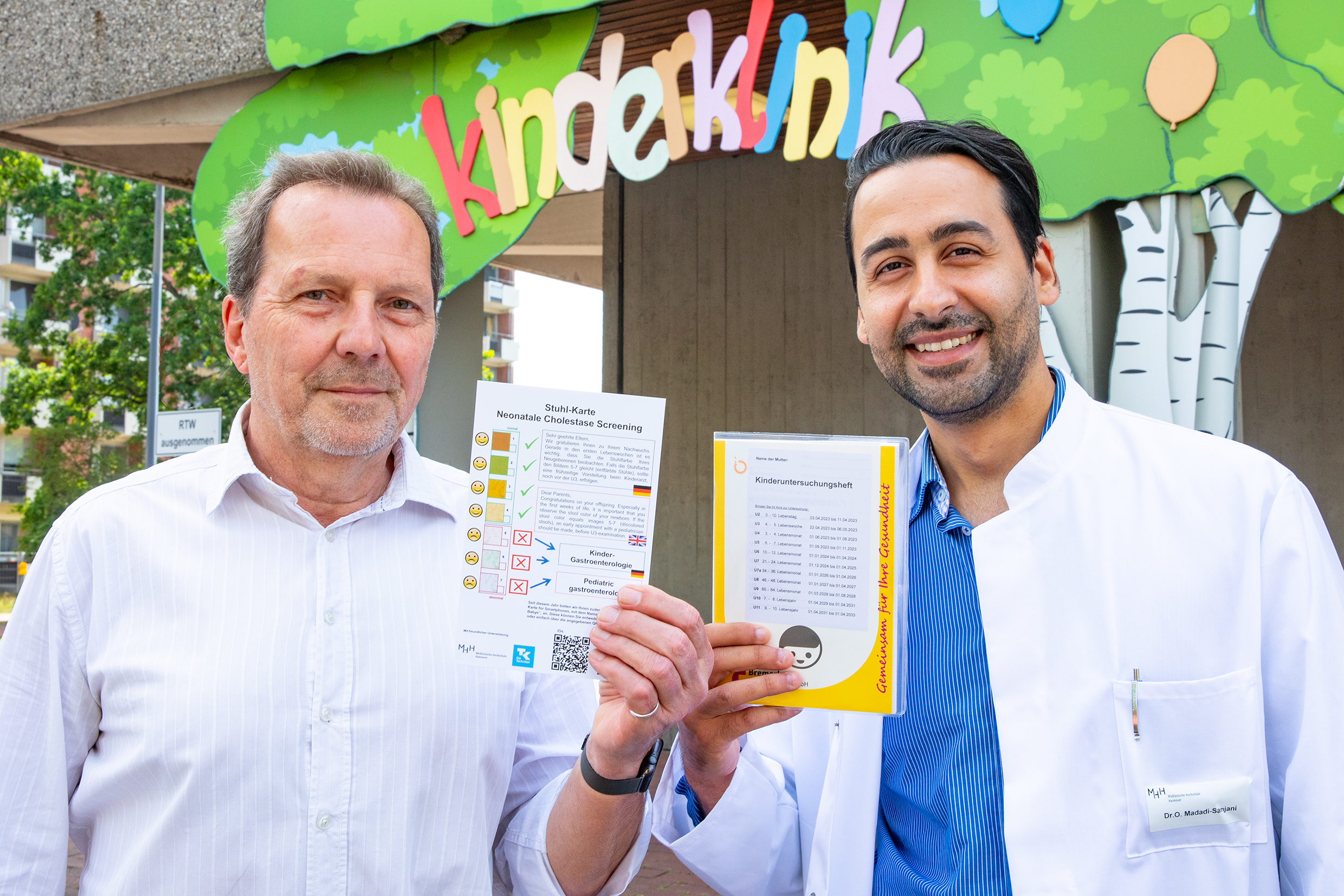A joint project of MHH and TK Niedersachsen is being implemented nationwide.

This is what the stool colour chart looks like, which will be a permanent feature of the Yellow Booklet. Professor Petersen (left) and Dr. Madadi-Sanjani are pleased that bile duct atresia can now be diagnosed earlier. Copyright: Karin Kaiser / MHH
12. July 2023
Biliary atresia is a rare condition, but it can have serious consequences even in the first weeks of a child's life. Atresia is an irreversible obstruction of the bile ducts, which leads to the destruction of the liver within a few weeks. "The only chance of preventing this lies in a very early diagnosis," explains Dr Omid Madadi-Sanjani from the Department of Paediatric Surgery at Hannover Medical School (MHH). The senior physician and his now former colleague Professor Dr Claus Petersen have been working together with the Techniker Krankenkasse (TK) Lower Saxony for many years to strengthen the early detection of biliary atresia. Now they can be happy about a great success: A stool colour card, which can give indications of a possible bile duct obstruction, will become an integral part of the yellow booklet - and can thus be used for all newborns nationwide. This innovation was initiated in May of this year by a decision of the Federal Joint Committee (G-BA).
Early surgery is a chance for the liver
About one in 19,000 newborns is affected by biliary atresia. The obstruction of the bile ducts causes the bile to back up. If left untreated, this leads to fatal liver failure in the second or third year of life. The typical symptoms of the disease, which already appear in the first weeks of life, include persistent jaundice and pale stool colour. The disease can only be treated surgically. The time factor plays a decisive role in success. "If the child is operated on by a qualified team in the first two months of life, about 50 percent of these children can survive in the long term with their own liver," explains Professor Petersen. All the others receive a liver transplant sooner or later, which ensures survival but is associated with many lifelong restrictions.
Supply gap is closed
Together with the TK, MHH has been actively promoting early diagnosis of biliary atresia since 2014. Since the end of 2016, all maternity clinics in Lower Saxony have been provided with stool cards for early detection, and in 2021 the stool card was digitalised and has since been available to all parents nationwide as the "Liver Check for Babies" app. With its inclusion in the Yellow Booklet, another big step has now been taken. "From our point of view, it is important to educate and act early, even in the case of rare diseases. Otherwise, there is a risk that these diseases will slip through the system. It is therefore all the more gratifying that the use of chair cards in the Yellow Booklet can now also close a gap in care nationwide," says Dirk Engelmann, head of the TK regional office in Lower Saxony.
All parents receive the Yellow Booklet after the birth of a child from the maternity ward or the midwife. All examination results from U1 to U9 are recorded in the child examination booklet. According to estimates by the G-BA, the new Yellow Booklets, which have been expanded to include the stool colour card, can probably be distributed from autumn of this year.
Important tool for parents
The stool colour chart itself is not a new invention. In Taiwan, Japan, Mexico and Switzerland, it has long been an integral part of the child examination booklet. With the integration into the Yellow Booklet, all parents in Germany now have the possibility to check the stool colour of their baby. The decision whether a finding is conspicuous or not is always made by a physician. "But the card is an important tool for parents," explains Dr Madadi-Sanjani. He will scientifically accompany the nationwide use of the stool colour card and observe its success - in the end, the life-threatening disease should be detected very early in more newborns.
Largest treatment centre in Germany
MHH is the largest treatment centre for children with biliary atresia in Germany, one of the three largest in Europe and also the site of a patient registry. The university is one of the founding members of the ERN initiative (European Reference Network) and is a member of the "rare liver" network there. "The combined expertise of patient care and research at a centre like MHH is of crucial importance, especially for young patients with such rare diseases as biliary atresia. Early detection and early treatment determine the success of treatment and thus the long-term prognosis," says Professor Michael Manns, President of MHH. In Germany, there are about 35 to 40 newborns with bile duct obstruction per year. One third of these are treated at MHH.
Author: Tina Götting